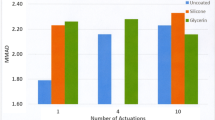Abstract
The calibration of the first stage of the twin-stage impinger, an instrument proposed for use in measuring the spray size from metered-dose inhalers, was performed with monodisperse aerosols by a standard technique for cascade impactors. The mean cut point was found to be not particularly sensitive to operating variables which may be expected to occur in practice. The cut point was close to that reported previously, although the collection efficiency curve was found to be slightly sharper. Calculations are reported on the expected results of measurements on aerosols in a two-stage instrument with an idealized perfect collection efficiency curve as well as the curve measured for the twin impinger. These results indicate that important characteristics of spray size distribution cannot be distinguished with an ideal two-stage instrument; the twin impinger is less capable than an ideal instrument.
Similar content being viewed by others
REFERENCES
S. P. Newman, D. Pavia, F. Moren, N. F. Sheehan, and S. W. Clark. Deposition of pressurized aerosols in the human respiratory tract. Thorax 36:52–55 (1981).
W. Stahlhofen, G. Rudolf, and A. C. James. Intercomparison of experimental regional aerosol deposition data. J. Aer. Med. 2(3):285–308 (1989).
P. R. Byron. Aerosol formulation, generation, and delivery using metered systems. In P. R. Byron (ed.), Respiratory Drug Delivery, CRC Press, Boca Raton, FL, 1990.
G. W. Hallworth. The formulation and evaluation of pressurized metered-dose aerosols. In D. Ganderton and T. J. Jones (eds.), Drug Delivery to the Respiratory Tract, VCH, New York, 1987.
I. Gonda. Study of the effects of polydispersity of aerosols on regional deposition in the respiratory tract. J. Pharm. Pharmacol. 52P (1981).
A. J. Hickey. Factors influencing aerosol deposition in inertial impactors and their effect on particle-size characterization. Pharm. Tech. 14(9):118–130 (1990).
E. M. Phillips, P. R. Byron, K. Fults, and A. J. Hickey. Optimized inhalation aerosols. II. Inertial testing methods for particle size analysis of pressurized inhalers. Pharm. Res. 7:1228–1233 (1990).
G. W. Hallworth and U. G. Andrews. Size analysis of suspension inhalation aerosols by inertial separation methods. J. Pharm. Pharmacol. 28:898–907 (1976).
G. P. Martin, A. E. Bell, and C. Marriott. An in vitro method for assessing particle deposition in inertial impactors and their effect on particle-size characterization. Int. J. Pharm. 44:57–63 (1988).
USP XXII/NFXVII, Mack, 1989, pp. 515, 735, 836.
G. W. Hallworth, and R. R. Hamilton. Size analysis of metered suspension pressurized aerosols with the Quantimet 720. J. Pharm. Pharmacol. 28:890–897 (1976).
P. J. Davies, K. K. Amin, and G. A. Mott. Particle size of inhalation aerosol systems. I. Production of homogeneous dispersions. Drug Dev. Ind. Pharm. 6:645–651 (1980).
G. W. Hallworth and D. G. Westmoreland. The twin impinger: A simple device for assessing the delivery of drugs from metered dose pressurized aerosol inhalers. J. Pharm. Pharmacol. 39:966–972 (1987).
British Pharmacopoeia, 1988, p. 875, Appendix XVII C, A204–A207.
P. A. Haywood, M. Martin-Smith, J. M. Padfield, I. J. Smith, and R. N. Woodhouse. Establishing more meaningful specifications and tests for metered-dose pressurized inhalers formulated as suspensions. Pharm. Forum 15(3):5193–5202 (1989).
A. G. Childers. Twin impinger testing for the evaluation of dose deposition of MDI products. In P. Atkins (ed.); Particle size of metered dose inhalers—current methodologies. In R. N. Dalby and R. Evans (eds.), Proceedings of the Second Respiratory Drug Delivery Symposium, March 26–30, 1990, University of Kentucky College of Pharmacy Office of Continuing Education, Lexington, Kentucky, 1991.
R. N. Berglund and B. Y. H. Liu. Generation of monodisperse aerosol standards. Environ. Sci. Technol. 7:147–153 (1973).
V. A. Marple, K. L. Rubow, and S. M. Behm. A microorifice uniform uniform deposit impactor (MOUDI) description, calibration and use. Aerosol Sci. Tech. 14:434–446 (1991).
J. B. Lodge and T. L. Chan (eds.). Cascade Impactors, American Industrial Hygiene Association Monograph Series, AIHA 475 Wolf Lodge Parkway, Akron, Ohio 44311-1087.
V. A. Marple, K. L. Rubow, U. Turner, and J. D. Spengler. Low flow rate sharp cut impactors for indoor air sampling: design and calibration. J. Air Pol. Cont. Assoc. 37:1303–1307 (1987).
W. C. Hinds. Aerosol Technology: Properties, Behavior, and Measurement of Airborne Particles, J. Wiley, New York, 1982.
R. N. Dalby and P. R. Byron. Comparison of output particle size distributions from pressurized aerosols formulated as solutions or suspensions. Pharm. Res. 5:36–39 (1988).
Author information
Authors and Affiliations
Rights and permissions
About this article
Cite this article
Miller, N.C., Marple, V.A., Schultz, R.K. et al. Assessment of the Twin Impinger for Size Measurement of Metered-Dose Inhaler Sprays. Pharm Res 9, 1123–1127 (1992). https://doi.org/10.1023/A:1015835301929
Issue Date:
DOI: https://doi.org/10.1023/A:1015835301929




